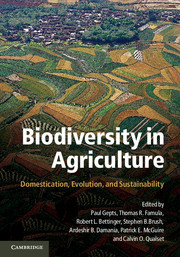Book contents
- Frontmatter
- Contents
- Tables
- Figures
- Foreword
- Contributors
- Acknowledgments
- Introduction: The Domestication of Plants and Animals: Ten Unanswered Questions
- 1 The Local Origins of Domestication
- Section I Early Steps in Agricultural Domestication
- Section II Domestication of Animals and Impacts on Humans
- Section III Issues in Plant Domestication
- Section IV Traditional Management of Biodiversity
- Section V Uses of Biodiversity and New and Future Domestications
- 22 Participatory Domestication of Indigenous Fruit and Nut Trees: New Crops for Sustainable Agriculture in Developing Countries
- 23 The Introduction and Dispersal of Vitis vinifera into California: A Case Study of the Interaction of People, Plants, Economics, and Environment
- 24 Genetic Resources of Yeast and Other Micro-Organisms
- 25 Biodiversity of Native Bees and Crop Pollination with Emphasis on California
- 26 Aquaculture, the Next Wave of Domestication
- 27 Genetic Sustainability and Biodiversity: Challenges to the California Dairy Industry
- Index
- References
22 - Participatory Domestication of Indigenous Fruit and Nut Trees: New Crops for Sustainable Agriculture in Developing Countries
Published online by Cambridge University Press: 05 June 2012
- Frontmatter
- Contents
- Tables
- Figures
- Foreword
- Contributors
- Acknowledgments
- Introduction: The Domestication of Plants and Animals: Ten Unanswered Questions
- 1 The Local Origins of Domestication
- Section I Early Steps in Agricultural Domestication
- Section II Domestication of Animals and Impacts on Humans
- Section III Issues in Plant Domestication
- Section IV Traditional Management of Biodiversity
- Section V Uses of Biodiversity and New and Future Domestications
- 22 Participatory Domestication of Indigenous Fruit and Nut Trees: New Crops for Sustainable Agriculture in Developing Countries
- 23 The Introduction and Dispersal of Vitis vinifera into California: A Case Study of the Interaction of People, Plants, Economics, and Environment
- 24 Genetic Resources of Yeast and Other Micro-Organisms
- 25 Biodiversity of Native Bees and Crop Pollination with Emphasis on California
- 26 Aquaculture, the Next Wave of Domestication
- 27 Genetic Sustainability and Biodiversity: Challenges to the California Dairy Industry
- Index
- References
Summary
Crop domestication has been limited to a very small proportion of some 250,000 plant species (0.04%). This equates to 0.5% of the 20,000 edible species (Leakey and Tomich 1999). The process of domestication in many of these species goes back thousands of years, for example, barley domestication started in the Neolithic Age, while fruits like oranges and apples go back about 3,000 years in China and central Asia respectively (Simmonds 1976). Against this background the domestication of tropical tree crops, such as mango and lychee, is very recent, probably only within the last century. Likewise, the concept of domesticating trees for timber and non-timber products in forestry emerged only within the last 30 to 40 years (Okafor 1980, 1983, Leakey et al. 1982, Leakey 1991). In 1992, a conference in Edinburgh recognized the need to domesticate the trees that have in the past provided poor people with their everyday needs for food, medicinal and other forest products (Leakey and Newton 1994a,b). At this conference, these species were described as “Cinderella species” because they have been overlooked by science and the “Green Revolution” (Leakey and Newton 1994c). The recent history of agroforestry tree domestication has been chronicled by Leakey et al. (2005a, 2007), and the products of these cultivated trees are now termed Agroforestry Tree Products (AFTPs) to distinguish them from the extractive resource of Non-timber Forest Products (NTFPs) (Simons and Leakey, 2004).
Agroforestry practices are especially numerous in the tropics and used by more than 1.2 billion people. They produce the products that are important for the livelihoods of millions of other people in developing countries. The area under agroforestry world-wide has not been determined, but probably exceeds 100 million hectares. Like organic farming, conservation agriculture and ecoagriculture, agroforestry addresses soil fertility management issues for the rehabilitation of degraded farming systems; loss of biodiversity above and below ground; carbon sequestration; and soil and watershed protection. In addition, agroforestry provides: (i) useful and marketable tree products for income generation, fuel, food and nutritional security/health and the enhancement of local livelihoods (Leakey et al. 2005d); (ii) functioning agroecosystems akin to natural woodlands and forests (Leakey 1996); (iii) linkages with culture through the food and other products of traditional importance to local people (Wynberg et al. 2003).
- Type
- Chapter
- Information
- Biodiversity in AgricultureDomestication, Evolution, and Sustainability, pp. 479 - 501Publisher: Cambridge University PressPrint publication year: 2012
References
- 11
- Cited by



